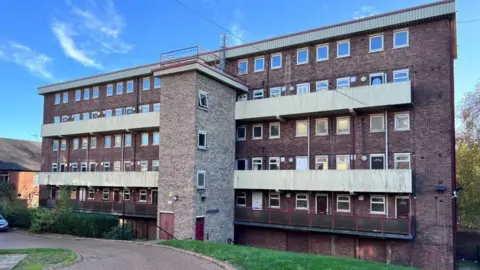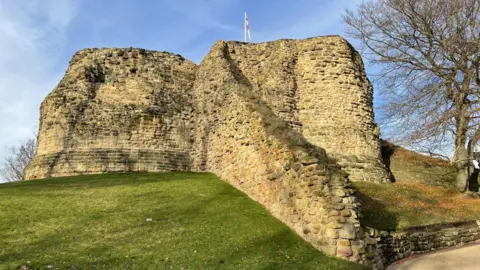Flats 'spoiling historic setting' to be demolished
 Prospect Archaeology
Prospect ArchaeologyFour blocks of 1960s flats in Pontefract, which "negatively contribute" to the area's historic setting, are to be demolished.
Wakefield Council has given the go-ahead for Violet Pritchard House, Silkstone House, Francis Lane House and Warren House - part of the Horsefair Flats complex - to be bulldozed.
The council's conservation officer said the complex "abruptly contrasts with the historic context of the area" and "undermines the significance of the castle".
The social housing provider plans to replace the buildings with new housing projects, according to documents submitted to the local authority.
Approving the proposals, a planning officer's report said it was accepted the flats "contribute little from a visual perspective to the local area" and their demolition would be "beneficial".
A heritage statement said the buildings are within the Pontefract Castle conservation area and less than 300m from the medieval monument, the Local Democracy Service reports.
According to the statement, the buildings make a "negative contribution" to the area and their demolition would be a "minor enhancement".
History of Pontefract Castle
 Dave Pickersgill/ Geograph
Dave Pickersgill/ Geograph- The castle was built in about 1070 by Ilbert de Lacy on land granted to him by William the Conqueror as a reward for his support during the Norman Conquest
- The deposed King Richard II was captured in August 1399 and initially imprisoned in the Tower of London, before he was moved to Pontefract Castle where he died in February 1400
- Royalists controlled Pontefract Castle at the start of the English Civil War and Oliver Cromwell led the final siege of the site which finally fell to his Parliamentarians in 1649
- Parliament decided the castle should be demolished, preventing it from being used against them in the future. Many of the buildings in the local area are made from stones recycled from the castle
Source: Duchy of Lancaster
Wakefield District Housing (WDH) submitted an application to knock down the buildings in December last year.
The flats are currently vacant after former residents were housed elsewhere.
The demolition phase is expected to take about 40 weeks to complete and the site will then be grassed over until redevelopment takes place.
WDH said it intended to submit a separate planning application for a new housing project on the land.
Planning permission was granted with a condition that a full archaeological recording takes place at the site before further development is carried out.
Listen to highlights from West Yorkshire on BBC Sounds, catch up with the latest episode of Look North.
